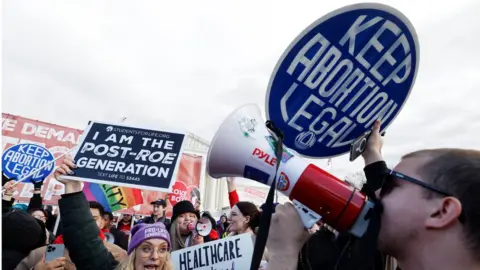Four ways the end of Roe v Wade has changed America
 Reuters
ReutersA year ago, the US Supreme Court delivered a historic ruling that ended the nationwide right to abortion, impacting the lives of millions of women and transforming the political landscape.
On 24 June, 2022, America's top court overturned the 1973 Roe v Wade ruling which had guaranteed women the right to an abortion up until the point of foetal viability, which is about 24 weeks.
In its Dobbs v Jackson Women's Health Organization decision, the conservative majority on the court turned over the power to regulate abortion - or ban it outright - to individual states.
The anti-abortion movement celebrated a landmark victory, while pro-choice activists warned of a looming public health crisis.
Here are four ways the US has changed in the year since:
1. Millions of women lost the right to an abortion
After spending almost half a century fighting to overturn Roe, opponents were prepared to take advantage when the moment finally came. Thirteen states had passed "trigger bills" that enabled them to begin the process of banning abortion immediately after the Dobbs decision.
A year on, 14 states, including most of the South, have enacted near-total bans from the moment of conception. Georgia banned abortion after six weeks, which is before most women know they are pregnant.
That means that about 22 million women of reproductive age live in a state that has banned abortion, according to the Guttmacher Institute, representing about a third of the total childbearing population.
Another five states have introduced bans after 12-20 weeks gestation, while court challenges against stricter abortion limits are still pending in five others. Millions more women will see their access to the procedure reduced.
"There's this sense that the end of Roe is catapulting us into an abortion-free future," Students for Life president Kristan Hawkins told the BBC last January during the annual March for Life protest.
But what access a woman has to abortion, depends on where she lives - and which party is in power in that place.
While many, if not all, Republican-controlled states have restricted access, lots of progressive states run by Democrats, such as California and Colorado, have introduced stronger legal protections.
2. American women had fewer abortions
Almost a million abortions were carried out in the US in 2020, the last year there is full data for, according to the Guttmacher Institute. The anti-abortion movement wants to get that down to zero eventually, but hopes the state-wide bans and tighter restrictions will dramatically reduce the total.
We do not know the full impact of the laws introduced so far. However, data provided by WeCount, a research initiative funded by the pro-choice Society of Family Planning, suggests a significant impact already.
According to WeCount, there were 24,290 fewer legal abortions overall between July 2022 and March 2023, compared to an average calculated in the months before the Dobbs decision. The project tracked abortions provided by clinics, private medical offices, hospitals, and virtual-only clinics, but did not track self-managed abortions.
Unsurprisingly, states with abortion bans showed the biggest declines. In contrast, legal abortions increased, but to a lesser degree, in neighbouring states where the procedure was protected, notably Florida, Illinois, and North Carolina.
3. Women travelled farther to get abortions
As illustrated by the WeCount data, many women in states who wanted an abortion chose to travel across state lines. As more states pass bans, the nearest clinic providing abortion services can be hundreds of miles away.
That led to longer journeys overall, a study published in the Journal of the American Medical Association found.
The study mapped the average travel time from census tracts to the nearest abortion clinic. Before Dobbs, the average journey to a clinic took between 10.0 to 27.8 minutes. After Dobbs, getting to the nearest clinic almost quadrupled, with upper-end travel times averaging over 100 minutes.
Dr Judy Levison, a Houston doctor who has been practising for four decades and is part of a lawsuit challenging Texas's ban, worries that is a barrier for low-income women who make up the majority of those who have abortions.
"Where were they going to get an abortion? How were they going to afford travelling, getting childcare, risking two days not working and risking their employment perhaps?" she told the BBC.
4. Support for abortion has increased
Support for abortion in the US has been steady over the past 30 years, with about 60% of Americans believing abortion should be legal in all or most cases, according to Pew Research. Overall, the think tank found that people's support for abortion goes down as a pregnancy continues.
But in the year after the Supreme Court decision, public support for abortion has actually gone up. And that's been the case, too, even in places which have instituted bans.
In 2019, about 31% of people in states that would later institute bans believed that abortion should be easier to access. But in 2023, after those bans were put in place, 46% of the population thought it should be easier, according to surveys conducted by Pew.
How people view abortion is still largely shaped by their politics - 84% of Democrats believe abortion should be legal in most cases, compared to 40% of Republicans. But when proposed abortion restrictions were directly on the ballot in conservative states, they have failed.
During the 2022 midterm elections, ballot measures failed in Kentucky and Montana, presenting a quandary for Republicans. Bans and restrictions are popular with the conservative base, but they risk turning off more moderate voters who believe abortion should remain legal.
With reporting from Nada Tawfik and Holly Honderich
